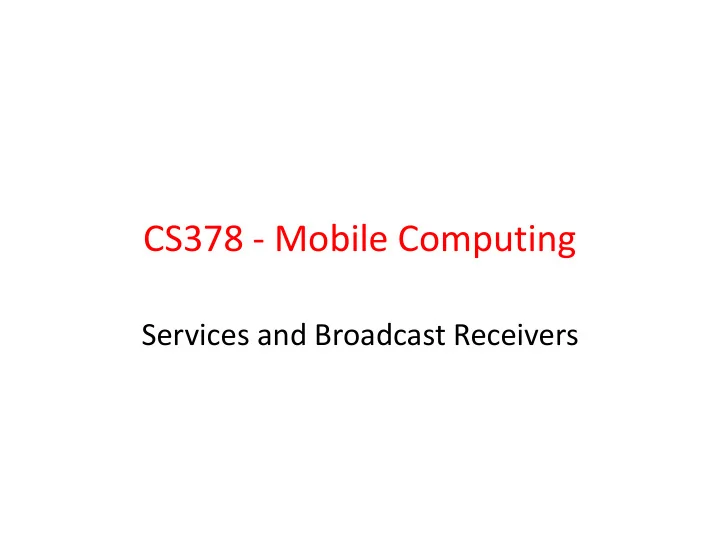

CS378 - Mobile Computing Services and Broadcast Receivers
Services • One of the four primary application components: – activities – content providers – services – broadcast receivers 2
Services • Application component that performs long-running operations in background with no UI • application starts service and service continues to run even if original application ended or user moves to another application 3
Forms of Services • Stated: – application component, such as an Activity, starts the service with the method call startService() – once started service can run in background indefinitely – generally services do not return a result (see bound service) – service should stop itself when done 4
Forms of Services • Bound – application component binds itself to existing service via the bindService() method – bound service provides client-server interface that allows application component to interact with service – interact with service, send requests, get result via IPC (inter process communication – service runs as long as one or more applications bound to it – destroyed when no applications bound 5
Forms of Services • Service can be started and later bound to other applications • private service (manifest) cannot be bound by other applications 6
Service or Thread • Past examples, kept UI thread responsive with other threads of execution, especially AsyncTask • Should services be used for this? • Service for actions that need to take place even if user not interacting with UI or has closed application • Example, do complex rendering of image to display to user. – Not a job for a service 7
Creating a Service • create subclass of Android Service class or one of its existing subclasses • override callback methods that handle important aspects of service lifecycle • most important of these are: – onStartCommand – startService – onBind – onCreate – onDestroy – stopSelf – stopService 8
Service Lifecycle • If component starts service with startService method (leads to call to onStartCommand) service runs until it calls stopSelf or another activity calls stopService • if component calls bindService (onStartCommand no called) service runs as long as at least one component bound to it 9
Service Lifecycle 10
Service Example • From Roger Wallace – wanted an app that would respond to texts (SMS) received when driving and respond with a message ("Driving - Get back to you soon.") – Initial version simply auto responds to all texts – how to change it so it responds only when driving? 11
Example Service Application • From The Android Developer's Cookbook • SMSResponder Application • Response stored in shared preferences • App simply allows changes to message 12
Using SMS • Permission in manifest file to send and / or receive SMS messages 13
ResponseSMS Basic App • All work done in onCreate method 14
ResponseSMS onCreate 15
Service Running app still running, and service has started 16
Simulating Texts • Calls and texts can be simulated between emulators • Start two emulators • Use messaging app to send text • Phone number is simply the emulator port number (visible at top of the emulator or in eclipse) 17
Dual Emulators 18
Emulator Texts 19
Testing Service 20
Creating a Service • Extend the Service class – adapter class exists, IntentService that handles a lot of the details • override onStartCommand – return an int describing what system should do for starting service – START_NOT_STICKY, if system kills service don't restart – START_STICKY, if system kills service then recreate, but does not redeliver intent – START_REDELIVER_INTENT, if system kills service then recreate and redeliver last intent 21
SMS Responder 22
SMS Responder - onCreate 23
Broadcast Receivers • The fourth main application component • "A broadcast receiver is a component that responds to system-wide broadcast announcements." • Android system sends multiple kinds of broadcasts – screen turned off, battery low, picture captured, SMS received, SMS sent 24
Broadcast Receivers • Applications can initiate broadcasts to inform other applications of status or readiness • Don't display UI – may create status bar notifications • Usually just a gateway to other components and does very minimal work – initiate service to perform based on some event • Broadcasts are delivered as Intents 25
Broadcast Receivers • receive intents sent by sendBroadcast() method • LocalBroadcastManager to send Broadcasts within your application only • In SMS responder register receivers • unregister when service destroyed • key point: override the onReceive method for BroadcastReceiver subclass 26
BroadcastReceivers • What broadcasts are available? • Check the Intent class • http://developer.android.com/reference/and roid/content/Intent.html – search for "Broadcast Action" • Also look in android-sdk\platforms\<number>\data\ broadcast_actions.txt 27
Broadcasts 28
Broadcasts • from broadcast_ actions.txt in sdk files • platforms-> <api level>-> data\ 29
SMS Received - Broadcast Receiver 30
SMS Data • The SMS data in the Bundle (map) is under the key "pdus" – pdu, protocol data unit (some sources indicate protocol description unit) 31
respond method • incoming SMS messages trigger respond method 32
Stopping Service • Once started service runs until device shut down • Starts again when app started again • Add option to start and shut down the service 33
Starting Service 34
Checking Running Processes 35
Recommend
More recommend